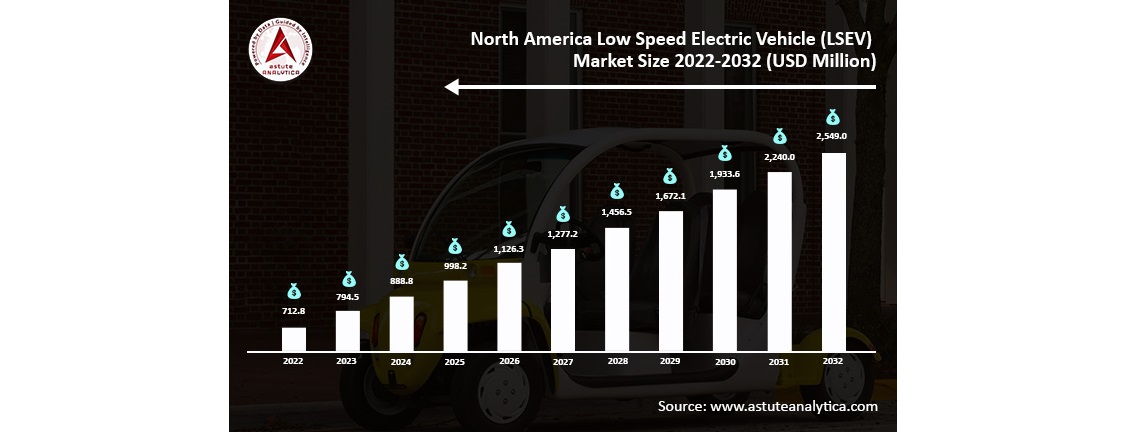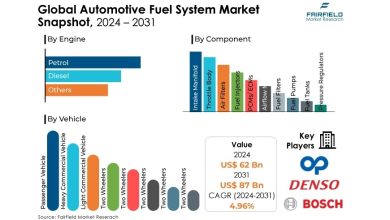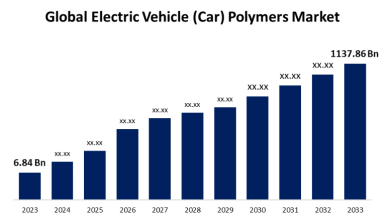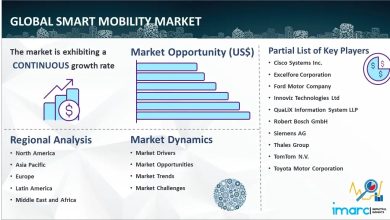North America’s low speed EV market to hit $2.5B by 2032

New Delhi (GLOBE NEWSWIRE) — According to Astute Analytica, the North America low speed electric vehicle market is projected to attain a market size of US$ 2,549.0 million by 2032 from US$ 794.5 million in 2023 at a CAGR of 13.83% during the forecast period 2024–2032.
The North American LSEV market is experiencing steady growth, finding a unique space in planned communities, resorts, educational campuses, and urban areas. These electric vehicles fill a need for localized, convenient transportation where their speed restrictions are less of a concern. Key players like Polaris, Textron, and Club Car offer a diverse range of LSEVs, with a growing shift from lead-acid to lithium-ion batteries for improved range and efficiency. Wherein, California, Florida, and Arizona lead the way in LSEV adoption thanks to favorable weather and regulations. Ideal for streets with speed limits of 35mph or less, their urban and residential popularity is on the rise. Online and direct sales channels are expanding low speed electric vehicle market reach beyond traditional dealerships.
LSEVs offer a compelling blend of affordability and sustainability. With prices ranging from $8,000 – $12,000 and a 30–40-mile range per charge, they are an attractive alternative for individual use. However, golf courses, resorts, and commercial facilities are major buyers, often taking advantage of customization options for a tailored user experience. The low-speed electric vehicle market extends beyond sales, with rentals gaining popularity in tourist areas, resorts, and events. This offers an emission-free, convenient transportation option that aligns with growing environmental consciousness among consumers and businesses.
Key Findings in North America Low Speed Electric Vehicle Market
| Market Forecast (2032) | US$ 2,549.0 million |
| CAGR | 13.83% |
| By Vehicle Type | Commercial (56.90%) |
| By Voltage | 48V (43.37%) |
| By Battery | Lead-Acid Batteries (46.0%) |
| By Battery Capacity | 15-20KW (49.12%) |
| By Speed | 40 Km/h (39.8%) |
| By Application | Golf Course and Stadiums (23.0%) |
| Top Trends | Development of Low-Cost Lithium-Ion BatteriesAdoption of 3D Printing Technology for LSEV ManufacturingIncreasing Use of LSEVs as Personal Transportation Vehicles |
| Top Drivers | Growing Awareness of LSEVs as a Low-Cost and Eco-Friendly Transportation OptionFavorable Government Regulations |
| Top Challenges | Competition from SubstitutesMarket ConsolidationLimited Range |
Commercial Low Speed Electric Vehicles Captures Highest 56.90% Revenue Share
LSEVs are gaining traction in the North America low speed electric vehicle market as consumers and businesses alike seek out more sustainable transportation options. With a gross weight under 3,000 pounds and a top speed between 20-25 mph, these vehicles are finding increasing commercial applications. Most states allow LSEVs to operate on roads with speed limits of 35 mph or less, and they come equipped with federally mandated safety features like seat belts, lights, turn signals, and mirrors.
The demand for electric commercial vehicles (CVs) is being driven by both government policies aimed at limiting gas-powered vehicles and a growing preference for clean transportation options. LSEVs are proving especially popular for use on farms and in agriculture due to their efficiency and eco-friendliness compared to traditional gas-powered utility vehicles. Additionally, commercial LSEVs are finding use in last-mile delivery, on campuses, at airports, and in urban areas for short trips. Companies like AYRO are specializing in commercial LSEVs, offering vehicles designed for light-duty fleet needs.
While the upfront cost of LSEVs can still be higher than gas-powered alternatives in the low speed electric vehicle market, their operational costs are significantly lower. Charging infrastructure remains a challenge, especially for fleet operators, necessitating partnerships between LSEV makers, businesses, and charging providers. However, advancements in battery technology are promising, with more affordable chemistries like lithium iron phosphate (LFP) gaining market share. In 2022, LFP batteries reached their highest market share in a decade at just under 30%, signaling positive shifts for the overall affordability of electric vehicles.
Golf Courses and Stadiums are the Leading Consumers of North America Low Speed Electric Vehicle Market
Across the United States and Canada, there exists a vast network of sports facilities, with approximately 957 stadiums combined. Alongside this, the US boasts a staggering number of golf courses – nearly 16,000 at 14,000 facilities. This outstrips the number of even popular chains like Starbucks or McDonald’s. With around 75% of these courses being open to the public, golf maintains widespread accessibility. This creates a substantial market for LSEVs, as both stadiums and golf courses require efficient, eco-friendly transportation solutions.
Golf courses, in particular, are increasingly focused on sustainability. Their expansive footprint, often reaching 2 million acres across the US, highlights the potential environmental impact. Using LSEVs aligns with the growing desire of courses to reduce their carbon emissions, especially when operating in environmentally sensitive areas. Stadiums also present a unique opportunity for low speed electric vehicle market. Spectator-focused stadium courses, like TPC Sawgrass, demand efficient movement of guests, staff, and equipment across large areas. LSEVs offer a sustainable solution, facilitating smooth operations without the noise and emissions of traditional gas-powered vehicles. Their flexibility allows for diverse tasks within the stadium environment, further increasing their appeal.
15-20 kW Battery Capacity is Dominating North America Low Speed Electric Vehicle Market
Within the North America low-speed electric vehicle (LSEV) market, batteries with a 15-20 KW capacity are becoming increasingly prevalent. This trend is driven by their ability to strike a balance between cost and functionality. A 15-20 KW battery provides an adequate range, typically between 30-50 miles. This range is more than sufficient for the short trips and localized transportation purposes that LSEVs are designed for. Additionally, this battery size helps keep overall prices accessible, a crucial factor in the low speed electric vehicle market.
LSEVs have speed and weight limitations, making overly large batteries impractical. A 15-20 KW battery delivers a good range without adding unnecessary weight that could compromise the vehicle’s performance. Furthermore, advancements in battery technology have increased energy density, allowing manufacturers to fit more range into smaller and lighter battery packs – further solidifying the 15-20 KW range as a preferred option. Some of the popular LSEV models in the North American market are the Polaris GEM and Club Car. AYRO’s commercial vehicles often feature batteries within this capacity range. This underscores the practicality and widespread adoption of 15-20 KW batteries in this segment of the electric vehicle market.
Competitive Analysis: Top 9 Players Holds Up to 65% Revenue of North America Low Speed Electric Vehicle Market
The low-speed electric vehicle (LSEV) industry in North America is moderately consolidated. The top nine players capture up to 65% of the market share. These players include Accell Group N.V., Deere & Company, HDK Electric Vehicles, Ingersoll Rand, Inc., Pedego Electric Bikes, Polaris Industries, Sonders, Textron Inc., and Zero Motorcycle Inc. Key players like Polaris Industries, Textron Inc., Ingersoll Rand, and others bring diverse strengths to the table. Polaris leverages its expertise in powersports, offering rugged and adaptable LSEVs. Textron, deeply embedded in the golf cart industry, understands the specific needs of resorts and courses. This understanding enables them to tailor their commercial LSEVs accordingly. Ingersoll Rand’s industrial background could lead to durable, workhorse LSEVs.
Low speed electric vehicle market competition will likely intensify across several fronts. Companies able to continuously innovate, pushing boundaries in range, features, and design aesthetics will likely gain an edge. Specialization will also prove crucial. Manufacturers that successfully cater to specific market segments – whether focused on commercial fleet needs, resort transportation, or individual consumer preferences – might gain a loyal customer base. Moreover, balancing cost-effectiveness with features and overall performance will be essential to appeal to a price-conscious market segment.



